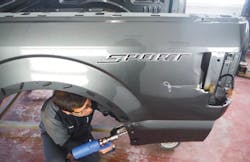If you go into this blind, Steve Marks says it will be like drinking from a firehose.
“Several years ago, you could not find the exact rivet gun you needed to save your butt,” he says. “Now there are so many to choose from, that for a shop owner going from scratch, it would be very challenging.”
As the industry technical support manager, Marks has worked with hundreds of shops over his 23-year career with I-CAR and understands how difficult it can be to narrow down your technicians’ rivet gun selection to a few select models. Your local market must be evaluated; OEM procedures must be consulted; various guns that are suited for flow form or blind rivets, grounded or threaded studs, aluminum or steel bodies must be reviewed—at times, the options can seem daunting.
But after you’ve put in the work, says Gary Wano Jr., owner of G.W. & Son Auto Body in Oklahoma City, finalizing a rivet gun collection is liberating. For a shop that is OEM certified in Mercedes, Volvo, Jaguar, Land Rover, Tesla and BMW, Wano Jr. has been able to ensure that his employees’ four rivet guns satisfy almost any repair procedure on any make.
Here’s how he and Marks say you can do it, too.
Evaluate Your Market
First and foremost when G.W. & Son opened, Wano Jr. sought out certification through Land Rover.
“My impression was there were more pickups and SUVs than high-end automobiles,” he says.
His impression, however—as you can probably gather due to his current list of OEM certifications—was wrong. A visit from a Mercedes representative showed Wano Jr. how many Benzes were roaming Oklahoma City, and Wano Jr. quickly realized he did not have the proper tooling and equipment—which included rivet guns—to properly service the market.
By utilizing resources like the Department of Transportation, Wano Jr. says you can strategically evaluate what automakers your shop will encounter most often and from there, what kind of rivet guns you’ll need to satisfy OE requirements. You may have a market dominated by a few select makes, or you may have a diverse market that necessitates a wide array of equipment.
"What we have found is (some guns) don’t do Ford work, which will be a problem if you’re getting a lot of Fords,” he says. “As a repairer, you have to find out what the market is. Just because you have the tool, doesn’t mean you're ready to repair the car.”
Research OEM Procedures
This triggers the next step: Once you’ve identified the makes hitting your shop, it’s then time to understand which guns will effectively repair those vehicles.
In order to buy the right rivet guns, it requires doing some homework, Marks says. While it’s not necessary to go through the level of training and expense required for earning an OEM certification, it is necessary to review the proper OEM procedures.
“It is very important for safe repairs, for restoring the integrity of the vehicle, that the rivet being used for application is the correct one noted by OEM,” he says. “There are just so many rivets. It would be easy to do nothing more than to consider the size without considering the hardness or the alloy of the material.”
When OEMs perform crash tests, they’re looking for rivets of a certain strength and size that will best retain the integrity of the cars, Wano Jr. says. In turn, this could create a problem in your shop if you’re not using the tools identified by OEMs.
And beyond the actual rivets and rivet guns necessary, Wano Jr. says some manufacturers actually restrict accessibility to parts for which you would need the riveting tool. For this reason, Wano Jr. has invested in OEM certifications to ensure his rivet guns can service any scenario.
“Jag and Rover restrict all structural components. So, if you have not gone through the roughly 10 days of training … you're not going to have access to a part you need to use the riveting tool to put in,” he says.
Build the Culture
—
Just because you’ve researched the OEM procedures and purchased the proper rivet guns doesn’t mean your technicians will always use the proper ones, Gary Wano Jr. says.
“If you turn a blind eye to it, they’ll break the rules and make the wrong decisions,” he says. “They need to go to the repair manufacturer and pull up repair instructions for every single repair.”
Wano Jr. says it’s essential to enforce this mentality at meetings and training, and to build a culture where every technician is conscious of what rivet gun is needed for each OEM. While it could make little difference in many cases, researching repair instructions could also determine whether it squeaks; could make a difference on the fit and finish; could bring the body lining down further than it needs to be.
In short: It could be unsafe.
Buy for Versatility
While market evaluation and OEM research is certainly essential for ensuring safe repairs, the final piece of the puzzle involves making a cost-effective purchase, Marks says. Even after narrowing down the makes and types of rivet guns necessary, there is a wide array of options left—and because of that, you’ll want to buy for versatility.
“If you do not get a rivet gun set that does SPRs (self-piercing rivets) and flow forms as well as break stems, then you may have to buy multiple rivet guns,” Marks says. “You want to make sure you're getting a rivet gun capable of using the rivet mandrel diameters that vary. So you'd have to make sure you're buying a rivet gun that will work for the rivet applications of the vehicle you plan to repair.”
Take Wano Jr.’s rivet gun lineup, for example: four guns that effectively service his six OEM certifications. With the exception of one gun required by a manufacturer, his guns cross over for several makes, which limited the amount of rivet guns he needed to purchase.
Luckily, Marks says, as competition intensifies and the market opens up, there will be more and more versatile rivet guns available each successive year. So, while it gives you more options to research, it will also offer the opportunity to ensure your guns cover several repairs.
“I think we are seeing more instances of one particular kind of SPR being used in other types of rivet guns,” he adds. “There are a few guns out there where dies that fit one gun will fit another. Even generic rivet guns are trying to achieve that these days.”
The Expected Budget
—
Gary Wano Jr. doesn’t beat around the bush; if you’re going to do the proper research and understand what rivet guns your technicians need, expect to pay a pretty penny for those tools.
Typically, if you’re going by OEM procedures, Wano Jr. says you can expect to spend between $8,000 and $12,000 for a proper rivet gun (Wano Jr. spent $70,000 on his collection). Those costs don’t include the training required to understand those tools and obtain OEM certifications.
Depending on your willingness to purchase the proper rivet guns, it could affect the makes you accept into your shop, Wano Jr. says. It may very well come down to the fact that you only service specific automakers if that is all you’re willing to spend on rivet guns.
About the Author

